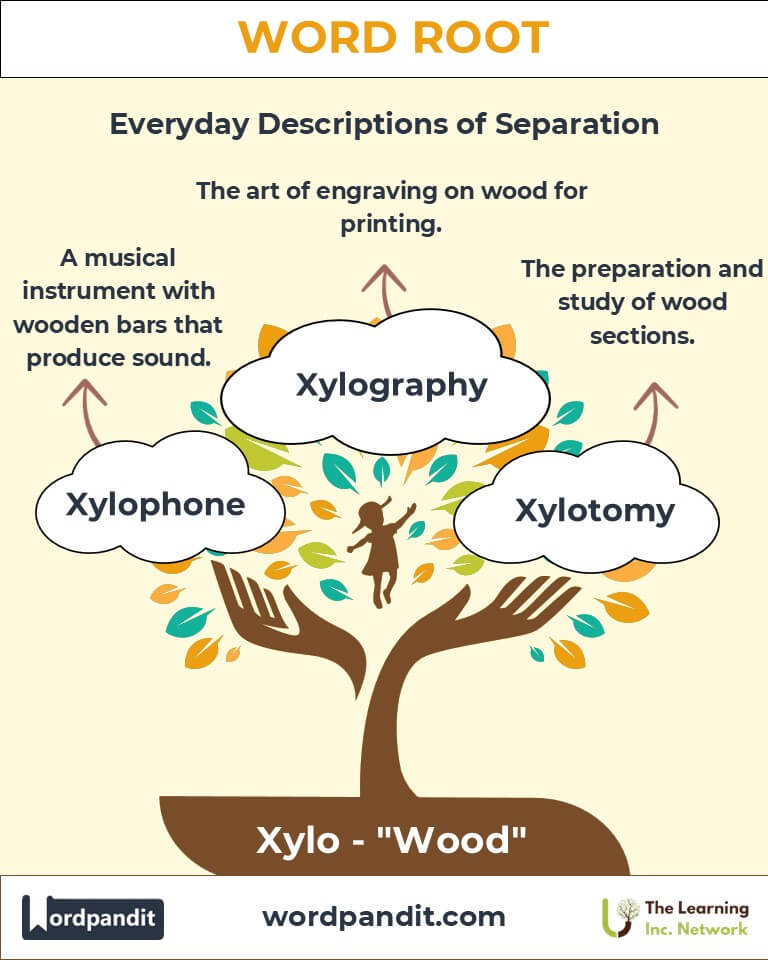Xylo: The Root of Wood in Language and Meaning
Discover the fascinating world of the root "Xylo," derived from the Greek word for wood. From the playful melodies of the xylophone to the scientific intricacies of xylem, "Xylo" brings the essence of wood to life in language, science, and culture.

Table of Contents
- Introduction: The Essence of Xylo
- Etymology and Historical Journey
- Mnemonic: Unlocking the Power of Xylo
- Common Xylo-Related Terms
- Xylo Through Time
- Xylo in Specialized Fields
- Illustrative Story: Xylo in Action
- Cultural Significance of Xylo
- The Xylo Family Tree
- FAQs About the Xylo Word Root
- Test Your Knowledge: Xylo Word Root Quiz
- Conclusion: The Living Legacy of Xylo
1. Introduction: The Essence of Xylo
The root "Xylo", pronounced zai-lo, originates from the Greek word xylon, meaning wood. This versatile root underpins words that reflect the properties, uses, and significance of wood across various disciplines. From the xylophone, a musical instrument that uses wooden bars, to xylem, the plant tissue responsible for transporting water, "Xylo" celebrates the enduring relationship between humanity and trees.

2. Etymology and Historical Journey
The root "Xylo" traces back to the Greek word xylon (wood). Ancient Greeks used "xylon" to describe wooden tools, structures, and even crucifixion crosses. Over centuries, the root "Xylo" expanded into other languages, inspiring words that capture wood’s physical and symbolic importance in art, science, and spirituality.
3. Mnemonic: Unlocking the Power of Xylo
To remember "Xylo," picture a vibrant xylophone, its wooden bars glowing as they produce a cheerful tune. This image connects the root to the essence of wood and its transformative power.
Mnemonic Device: "Xylo brings wood to life, from melody to biology."
4. Common Xylo-Related Terms
- Xylophone (zai-luh-fohn)
- Definition: A musical instrument with wooden bars struck to produce sound.
- Example: "The xylophone's warm tones delighted the audience."
- Xylem (zai-luhm)
- Definition: Plant tissue that transports water and nutrients.
- Example: "The tree’s xylem ensured its leaves received adequate water."
- Xylography (zai-log-ruh-fee)
- Definition: The art of engraving on wood for printing.
- Example: "Traditional xylography created stunning prints with intricate details."
- Xyloid (zai-loid)
- Definition: Resembling wood in texture or appearance.
- Example: "The fossil had a distinctly xyloid structure."
- Xylotomy (zai-lot-uh-mee)
- Definition: The preparation and study of wood sections.
- Example: "Xylotomy helps identify tree species through microscopic examination."
5. Xylo Through Time
- Xylosma:
- Past: A genus of shrubs and trees, its name reflects its woody nature.
- Present: Still relevant in horticulture for landscaping.
- Xylography:
- Evolution: From ancient woodblock printing to modern artistic techniques, xylography remains a testament to wood’s role in visual storytelling.
6. Xylo in Specialized Fields
- Music:
- Xylophone: Central to orchestras and schools, showcasing wood’s acoustical properties.
- Botany:
- Xylem: Essential for plant survival, studied in ecology and agriculture.
- Art and Printing:
- Xylography: Used in traditional and modern printmaking for artistic expression.
- Medicine:
- Xylocaine: A local anesthetic derived from lignin, a woody polymer.
7. Illustrative Story: Xylo in Action
In a small village, young Leo discovered an old xylophone in his attic. Fascinated by its wooden bars, he taught himself to play, bringing joy to his neighbors. Simultaneously, his sister, a botanist, studied xylem in local trees to combat drought. Together, they demonstrated how "Xylo" connects art and science, enriching life in diverse ways.
8. Cultural Significance of Xylo
Wood has been central to human culture for millennia. From wooden instruments like the xylophone to woodblock printing in ancient China, "Xylo" reflects creativity and survival. Even in mythology, trees symbolize life and wisdom, reinforcing wood’s deep cultural resonance.

9. The Xylo Family Tree
- Lign (Latin: wood)
- Example: Lignin – A polymer in plant cell walls.
- Silva (Latin: forest)
- Example: Sylvan – Relating to woods or forests.
- Arbor (Latin: tree)
- Example: Arborist – A tree care specialist.

10. FAQs About " Xylo "
Q: What does the root "xylo" mean?
A: The root "xylo" comes from the Greek word "xylon," meaning "wood." It appears in words related to wood or wooden objects, such as "xylophone" (a musical instrument with wooden bars) and "xylography" (wood engraving).
Q: What is a xylophone?
A: A xylophone is a musical instrument made of wooden bars that produce sounds when struck with mallets. Its name combines "xylo" (wood) and "phone" (sound).
Q: How is "xylography" connected to "xylo"?
A: "Xylography" is the art of engraving on wood to create prints or designs. It combines "xylo" (wood) and "graphy" (writing or drawing).
Q: What is xylophagy?
A: Xylophagy refers to the act of eating or consuming wood. It is often used to describe organisms, such as termites, that feed on wood as a primary food source.
Q: What is a xylophile?
A: A xylophile is someone who loves or has a strong appreciation for wood and wooden objects, reflecting the root "xylo," meaning "wood."
11. Test Your Knowledge: " Xylo " Mastery Quiz
1. What does "xylo" mean?
2. What is a xylophone?
3. What does "xylography" describe?
4. What does xylophagy refer to?
5. What is a xylophile?
12. Conclusion: The Living Legacy of Xylo
The root "Xylo" underscores the enduring relevance of wood in language, science, and art. From the structural marvels of xylem to the musical charm of the xylophone, it captures the transformative potential of nature. As we continue to innovate and connect with the natural world, "Xylo" remains a vibrant reminder of wood’s role in human progress.












